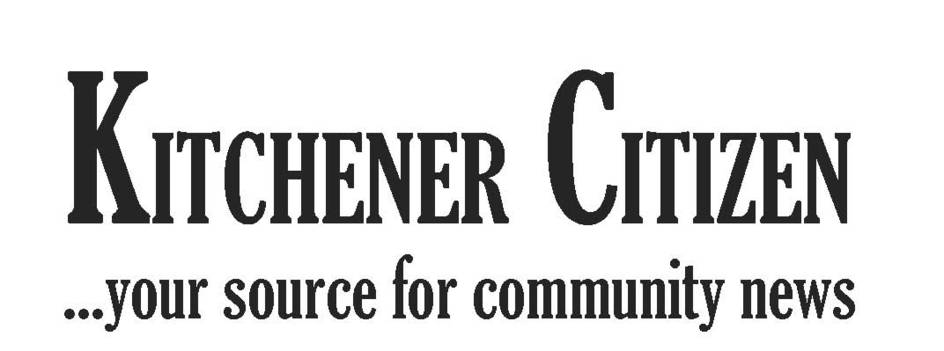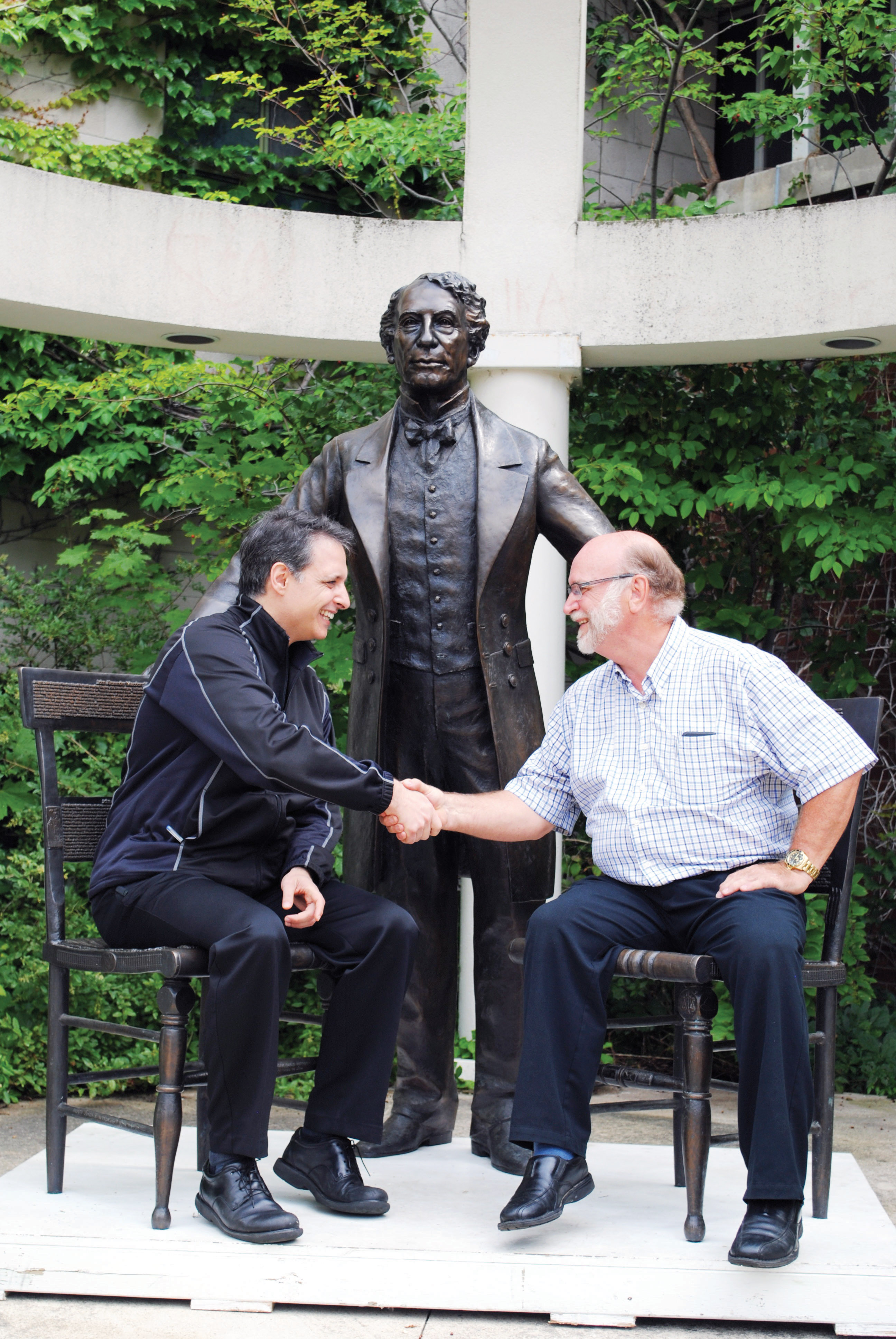

PROJECT FOR CANADA’S 150TH BIRTHDAY
Prime minister statues find a home at Wilfrid Laurier University
Prime minister statues find a home at Wilfrid Laurier University
A CANADIAN CONVERSATION
Co-chairs of the Prime Minister Statue Project Dave Caputo, left, and Jim Rodger celebrate the fact that they have found a home for their sesquicentennial statues at Wilfrid Laurier University. They are raising funds to have 22 bronze statues of former Canadian prime ministers created. An educational curriculum support is being written to accompany the public art. Photo by Helen Hall
Co-chairs of the Prime Minister Statue Project Dave Caputo, left, and Jim Rodger celebrate the fact that they have found a home for their sesquicentennial statues at Wilfrid Laurier University. They are raising funds to have 22 bronze statues of former Canadian prime ministers created. An educational curriculum support is being written to accompany the public art. Photo by Helen Hall
For News Tips & Advertising call...
Kitchener East - 519-578-8228
Kitchener West - 519-394-0335
 by Helen Hall
by Helen HallKitchener Citizen
July 9, 2015
They were better prepared this time.
After having their Prime Minister Statue Project rejected by Kitchener City Council in 2014, the organizers made sure they worked through all the details with their partner before announcing it to the public.
Last week, during a presentation at Wilfrid Laurier University (WLU), president Max Blouw said that the 22 statues of former Canadian Prime Ministers will be located at various locations on Laurier’s Waterloo campus.
“Historical figures are rarely neutral in the eyes of the public,” explained Blouw.
“By providing a home for the Prime Minister statues at our university, we believe that we can foster a more complete and open discussion, and a deeper shared appreciation of our history as a nation,” Blouw said.
“There is no better place than a university - with our tradition of inquiry, teaching and academic freedom - for all the elements of our history to be examined, discussed and more deeply understood.”
Blouw went on to say that the university is considering extending the project, to include other national figures such as “aboriginal leaders, prominent women, and other historically significant people.”
The first statue to come to Laurier is of Sir John A. Macdonald, which was first unveiled in January at a
Kitchener Rangers game.
It is called A Canadian Conversation because it
includes two chairs that invite people to sit with
Macdonald for a discussion. Blouw said it will
eventually be moved to Laurier’s western entrance at Waterloo Park, where the ION station will be located.
During the announcement, one person spoke out against the statues and suggested aboriginal leaders would be more appropriate.
In what could be described as a very Canadian conversation that could have happened on Macdonald’s bronze chairs, everyone quietly listened while the objector gave his reasons for opposing the statues.
He was thanked by Blouw for stating his opinion. Blouw reiterated that the university is considering adding other national leaders, including aboriginals, to the collection in the future.
The Prime Minister Statue Project is co-chaired by Sandvine CEO Dave Caputo and former Kitchener Collegiate principal Jim Rodger.
They have been raising funds since 2013 for the more than $2-million public art project for Canada’s 150th birthday in 2017.
Kitchener rejected the project because of the results of an online survey, completed by 2,441 respondents, or about 1% of Kitchener’s population.
Of the respondents, 1,920 said they did not want the statues in Victoria Park.
Some said they did not want the statues because Canada’s former prime ministers were racist, not multicultural, and predominately male.
Former Kitchener mayor Carl Zehr was the only council member not to dismiss the project for Kitchener.
“I still think Victoria Park would have been a good public venue for the statues as an enhanced tourism attraction and as an instructive educational tool for generations to come,” Zehr said last week.
“Obviously, I accepted the decision of council, however; as I stated the night of the vote, I believe it was very unfortunate to have made a decision based primarily on the results of a survey prior to allowing any meaningful discussion on the benefits that could accrue from the statue collection,” he said.
Caputo said that coming to an agreement with Laurier for the statues is an “incredible milestone” and that the “educational component is a critical part” of the project.
The statues are interactive, and include what are called “easter eggs” or symbols that students can use to learn more about the leader.
A curriculum support is being created to accompany the statues, which will be hosted by e-learning provider D2L (formerly called Desire2Learn), and will be available across Canada.
Caputo said he looks forward to the day when thousands of elementary school students visit the statues, and perhaps one day one of them will “grow up to be a prime minister.”
Rodger said he thinks the statues will be a “creative and intelligent presence in Waterloo Region.”
Acknowledging the challenges of leading the project, he quoted Canadian historian and educator Desmond Morton:
“Canadians, like their historians, have spent too much time remembering conflicts, crises, and failures. They forgot the great, quiet continuity of life in a vast and generous land. A cautious people learns from its past; a sensible people can face its future. Canadians, on the whole, are both.”
In an interview, Rodger said similar projects, such as the City of Presidents in Rapid City, South Dakota, also had opposition when initially discussed, but that statue project is now a very popular spot for tourists and educators, and its collection continues to grow.
The first statue of Sir John A. Macdonald was on display during the Laurier announcement. Macdonald was sculpted by Ruth Abernethy, an accomplished Canadian artist who is known for her sculptures of Glenn Gould at CBC in Toronto, Oscar Peterson in Ottawa, and the Mackenzie King statue in front of Kitchener Collegiate.
Abernethy, of Wellesley, also remarked on the challenges faced by the project organizers.
“If I had the luxury to time travel, I would go to a time in history when no mistakes were made,” she said.
“The only thing worse than celebrating the politicians we have, would be living in a time where no one wants to stand up for the task.”
In 2012, members of the House of Commons Standing Committee on Canadian Heritage published a report titled “Canada’s 150th Anniversary in 2017.”
One of the ways it suggests to celebrate the sesquicentennial is to encourage “new works of artistic expression created for Canada’s 150th anniversary.”
The statue project has been endorsed by Governor General of Canada David Johnston.
Project organizers are hoping that most of the statues will be ready by Canada’s 150th birthday in 2017.
The university said it will create a curatorial advisory board. One of its jobs will be to help determine locations for the statues on the Waterloo campus.